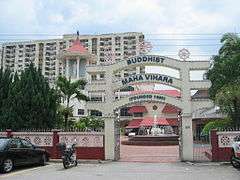Buddhist Maha Vihara, Brickfields
| Buddhist Maha Vihara | |
|---|---|
|
Dhammikarama Burmese Temple entrance | |
 Buddhist Maha Vihara Location in Malaysia | |
| Geography | |
| Country | Malaysia |
| State | Kuala Lumpur |
| District | Brickfields |
| Architecture | |
| Architectural styles | Sri Lankan |
| History and governance | |
| Date built | 1895 |
| Part of a series on |
| Buddhism |
|---|
 |
|
Buddhist Maha Vihara, Brickfields is a Buddhist site founded by the Sinhalese community based in the areas surrounding Kuala Lumpur to provide a place of worship in the Sri Lankan Theravada Buddhist tradition. It is also commonly known as the Brickfields Buddhist Temple. The Buddhist Maha Vihara’s growth and flourish over the past 50 years is attributed to the guidance and efforts of Ven. Dr. K. Sri Dhammananda whose vision is to enable a Malaysian Buddhist community to practice their beliefs in a caring and sufficient environment.
Ven K. Sri Dhammaratana (nephew of Ven. Dr. K. Sri Dhammananda was installed as chief monk of the Maha Vihara in Brickfields on October 8, 2006. He replaced Ven. Dr. K. Sri Dhammananda, who died on August 31, 2006 at the age of 87. On March 12, 2007 Ven K. Sri Dhammaratana was officially appointed as the Chief Sangha Nayaka (Chief High Priest of Malaysia).
The Sasana Abhiwurdhi Wardhana Society is responsible for the administration of the temple and all activities conducted on site. Religious activities here are jointly organized by the Sasana Abhiwurdhi Wardhana Society and the Buddhist Missionary Society Malaysia which has its headquarters here as well.
Chief Monk
- 1950s to 2006
Ven. Dr. K. Sri Dhammananda Nayaka Maha Thera (Chief Sangha Nayaka of Malaysia and Singapore)
- 2007 to present
Ven K. Sri Dhammaratana Maha Nayaka Thera (Chief Sangha Nayaka of Malaysia)
Other Resident Monks
- Ven. K. Vijitha Thera
- Ven. K. Piyananda Thera
- Ven. K. Karunasara Thera
- Ven. M. Vajiragnana Thera
- Ven. K. Dhammadinna Thera
- Ven. K. Ganawimala Thera
Tradition: Theravada, Sri Lankan
Services Offered
- Full Moon and New Moon Day services
- Buddhist Institute Sunday Dhamma School (BISDS)
The BISDS was formed in 1929 by the Sasana Abhiwurdhi Wardhana Society to disseminate Buddhist knowledge amongst the lay people with monks acting as teachers in the temple. What began as a small group of 12 students under the temple’s Bodhi tree grew into a highly modern and well run school with a group of dedicated volunteer teachers who are responsible for organizing many of the extra curricular activities. In 1961, the Malaysian Government provided five fully furnished classrooms within the temple grounds. Since 1974, the number of students rose steadily. In order to accommodate the rise of numbers the classrooms were then demolished in 1989 to make way for a 3-storey multipurpose building called the Wisma Dharma Cakra which today houses 20 classes capable of accommodating about 1,300 students including a library and resource centre.
- Sri Dhamma Library
- Bookshop
- Correspondence Course
- Registration of Marriages
- Rental of premises
- Services rendered by Monks
- Tadika Sudharma (Kindergarten)
External links
- Buddhist Maha Vihara Malaysia Website
- Ven. Dr. K. Sri Dhammananda Nayaka Maha Thera’s Website
- Photoessay and Panorama of the Buddhist Maha Vihara
Coordinates: 3°07′41″N 101°41′12″E / 3.128097°N 101.686701°E

%2C_Sentul%2C_Kuala_Lumpur.jpg)


